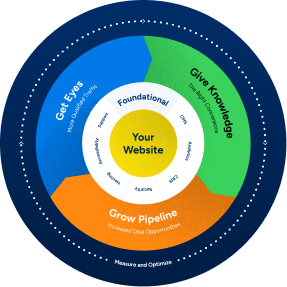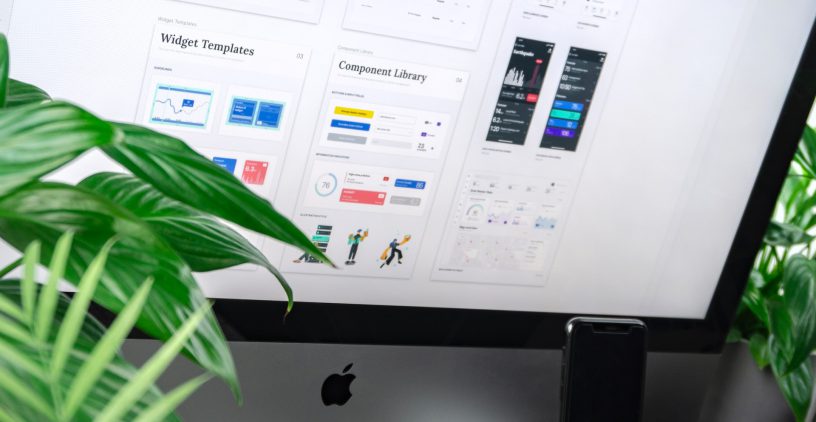There are many differences between B2B companies and B2C companies, so it should go without saying that the web designs used for these companies cannot be the same. Using the same web design that works for B2B websites for a B2C website is like trying to fish in a swimming pool — it’s pointless.
There are several subtle differences between B2B web design and B2C web design that aren’t as clear when first comparing the approaches, but they’re very important.
This article will take a closer look at the top five differences that matter the most and discuss why they’re so important.
B2B and B2C eCommerce: What’s the Difference?
Before getting into the differences between web designs, let’s take a quick look at the difference between B2B eCommerce and B2C eCommerce.
B2B eCommerce companies are typically wholesalers or manufacturers that sell to other businesses. Those businesses, the B2C companies, sell their products to consumers.
This is a simplified look at B2B and B2C business models, but that’s basically what it comes down to. B2B’s market is B2C companies, and B2C’s target audience is the general public. For example, Walmart is a B2C company, and Amazon is a B2B company.
Differences Between B2B and B2C Web Design
The many differences between B2B and B2C websites are often very subtle, but they make a big difference in how the websites are planned and created.
1. Content
The content on a website is of the utmost importance, no matter what kind of business you’re running.
B2B
One of the biggest differences between the web designs of B2B and B2C companies is the kind of content they focus on. B2B websites will have content that is all about teaching buyers how useful their products or services can be. There isn’t as much ‘emotional selling’ and more factual content.
Typically, these websites will consist of detailed and in-depth product videos (video marketing can be very effective for B2B sales) to thoroughly explain what the products do. There will also be more comprehensive buying guides and the articles are logical and extensive.
B2B content also includes case studies that highlight customer success stories and offer easy ways of contacting the seller.
B2C
The content on a B2C website will have more visuals that appeal to the audience, many action verbs, and emotional triggers that create the desire to buy. Reviews and ratings will be included to encourage buyers, and there may even be discounts or special offers.
A well-designed B2C website should offer a personalized experience based on the browsing and purchasing habits of website visitors.
B2C websites are also often quite flashy and dynamic when it comes to graphics. This is aimed at promoting a sense of urgency in visitors so they’re more likely to make a purchase.
2. Homepages
The homepage of a website is very important, and it’s used by website visitors to determine how trustworthy a company is.
B2B
In general, the homepage of a B2B company should be clutter-free and minimalistic. The design should be straightforward, informative, and with high-quality images of the product on offer.
B2B homepages should also make it easy for visitors to learn more about the product, as they’re often comparing various options at one time and don’t have time for ‘salesy’ tactics.
B2C
A B2C homepage should be more colorful and have a big focus on getting visitors to move down the sales funnel with ease. Special offers, sales, and discounts should take the center stage rather than factual information.
Creative and catchy headlines and vibrant design are at the order of the day for B2C homepages. It’s more common for B2C website design to take a ‘think outside the box’ approach than it is for B2B websites.
3. Call-to-Action (CTA)
The CTA is where you convince your website visitors to take the next step in the buyer’s journey. Typically, CTAs come in the form of buttons with encouraging text like ‘Get Now’ or ‘Contact Us Today’.
B2B
On the website of a B2B company, the CTA is straightforward and to the point, without a lot of extra creativity necessary. The copy must be enticing but practical without being too boring.
B2C
Colors are very powerful when it comes to CTAs on B2C websites. They can make a simple button stand out and get more clicks. It’s also a good idea to give visitors several different CTAs so they can get to know their options.
The button should be very creative, urging visitors to click despite their initial (and natural) resistance.
4. Customer Support
Customer support is crucial for both B2B and B2C companies, though the approaches vary a little bit.
B2B
Most B2B companies are relying on a self-service model nowadays. Still, well-planned customer support is important, and having live chats or video chats available is the norm for B2B companies.
It’s especially important to have active customer support available during the checkout process.
B2C
For B2C companies, customer support is more focused on answering common questions and dealing with post-sales problems like exchanges. Self-service is preferred in most cases.
Many B2C companies have various customer support channels and even use social media to handle issues quickly and effectively.
5. Purchasing Process
Although the basic purchasing process is similar for both B2B and B2B companies, there are small differences to take note of.
B2B
Typically, B2B companies have a more complex purchasing process than you’ll find used by B2C companies. Every step of the buyer’s journey needs to be nurtured efficiently and potential customers usually need more information to better understand products or services.
It’s important to give customers access to any info they may need as they move through the sales funnel to prevent them from losing interest.
B2C
In general, B2C customers don’t need as much time to learn more about products or services and can be moved down the sales funnel much faster. The purchasing process should thus be more convenient than information-heavy.
Encouraging sales is done through creative web design rather than accurate information sharing.
Request a FREE Website and Digital Consultation!
Looking for a B2B marketing agency that will help you achieve your goals? GoingClear is a dedicated team of designers, developers, marketers, and strategists located in Boston, MA. We will help you bring your B2B website project to life while hitting all those KPIs that matter most to you.
The Ultimate Guide to B2B Web Design
Check out the Ultimate Guide to B2B Web Design and download our checklist!

